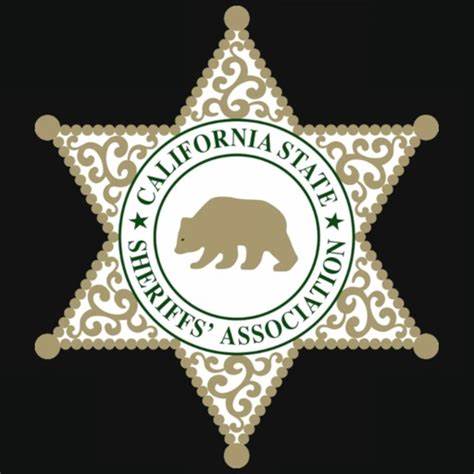When I was elected Sheriff in 1979, I had no knowledge of, or much interest in, any of California’s other Sheriffs. My focus was on San Francisco, and before I ran for office and was working under Sheriff Richard Hongisto I had no real contact with other counties while practicing law on behalf of the City’s county jail prisoners. In my first term in office, I was initially so overwhelmed just with the prospect of being the Sheriff that I gave no thought whatsoever about any other Sheriffs in California.
Not too long into my first term as Sheriff, out of the blue I got a phone call from the Sheriff of Kern County, a guy named Al Loustalot. He was the President of the California State Sheriff’s Association (CSSA) at the time and was calling me to say that I should get involved with the group. It turned out that Sheriff Loustalot was one of those guys I would classify as a “gentleman Sheriff.” He was old school polite, soft spoken and very welcoming. I hadn’t given any thought at all about getting together with the other Sheriffs, figuring that I was politically way to the left of them (which was true) and that we wouldn’t have anything in common (which was not true at all). Sheriff Loustalot told me that the State Sheriff’s Association would be having a meeting very soon and that he would love to see me attend. I said I appreciated his call and would give it some thought.
It looked like most of the State Sheriff’s meetings were in the southern or middle part of the State. Northern California didn’t seem like a particularly favored destination for the group. Even so, I decided to attend one of their annual get togethers – mostly just to get out of the office for a couple of days. The meeting was in Monterey – which was a pretty nice place to go – so I drove my Volkswagen convertible down the coast to attend the meeting. And what an eye-opener that meeting turned out to be-- an open window into the political and social world of California’s elected Sheriffs.
Obviously, I was a fish out of water among this group, an oddity but not their first from San Francisco. Many years before, in the 1960’s, San Francisco Sheriff Matt Carberry had actually hosted a State Sheriffs meeting and, so the story goes, was under the influence when he fell off the speaker’s podium while addressing the attendees. Then, of course, there was “my sheriff”, Dick Hongisto, who had committed the unforgiveable sin of going into another Sheriff’s county without notice to give a talk about criminal justice reform. Sheriff Loustalot had written a blistering letter about that jurisdictional outrage, which had been forwarded to me by a friend. So it was with some trepidation that I even decided to show up at the Monterey conference.
Mostly, the Sheriff’s in attendance were polite and courteous, or just politely ignored me. Sheriff Loustalot was courtly and welcoming. There was friendly joshing at the cocktail parties, but for the most part, I felt warily welcomed and the various Sheriffs seemed glad that I had attended. At the time, there was seething resentment that the Sheriffs from the two largest urban areas, Los Angeles and San Francisco, didn’t participate in the Sheriffs Association. The sheriff of Los Angeles, Peter Pitchess, ruled over the largest sheriff’s department in the country and was derisively referred to as “God.” The Association wished to influence state legislation, so both LA and San Francisco were viewed as important contacts for the legislative powers in Sacramento.
As part of the annual conference there was a daylong meeting about pending legislation in Sacramento and whether the (CSSA) should take a position on any of the bills. The unstated rules were that if you were an elected Sheriff, you could vote if you were present at a meeting. Obviously, I was on the losing side of many of the votes, often the lone losing vote, but nobody seemed to take umbrage at my positions.
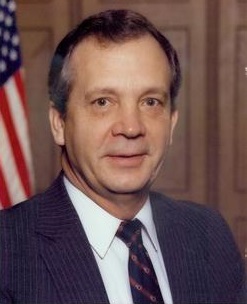
San Diego County Sheriff John Duffy (1930-1993) was first elected in 1971, serving five terms. He died of a heart attack at the age of 62 in El Salvador, while assisting that government in building a modern police force.
This was a moment of revelation to me and a moment of liberation. California is a gigantic state, but only has 58 counties. By comparison, my birth state of Iowa, one third the size of California, has 99 counties. Which means California has some big-ass counties. But, in terms of the CSSA’s elected county sheriffs, there was a general acknowledgement that the elected sheriff of a specific county represents his (or her) county’s interests.
I suppose this may be true of elected officials in general, but there were some pretty interesting characters among the Sheriffs. There was the aforementioned Los Angeles Sheriff Peter Pitchess (who no one ever saw), but also his successor, Sherm Block, a stocky balding guy who was in charge of the largest sheriff’s department in the nation. Unlike Pitchess, Sherm came to every meeting, every subcommittee and every conference, and knew every sheriff’s name and the minutiae of every piece of legislation affecting law enforcement. Same giant agency, completely different leader.
More common were the sheriffs from one of the non-urban counties, i.e., not from LA, San Diego, Sacramento or San Francisco. In California you have those “big four” and then a few “middle counties” with a mix of urban and rural (Marin, Santa Clara, Santa Cruz, Orange). But the other fifty or so counties are overseen by old fashioned rural sheriffs. Even those rural counties that have decent sized cities, like Orange County (Anaheim) or Riverside County (Riverside), the cities in those counties have their own major police departments and the Sheriff serves the vast rural and small-town areas of the county. Take Riverside County for example: the county is as large as the State of New Jersey, but while the Sheriff doesn’t serve the city of Riverside, he or she has to drive 180 miles to get from one side of the county to the other to provide public safety. Or Trinity County in the north with 3000 square miles, no incorporated cities, no traffic lights, no parking meters and a sheriff’s department with about a dozen deputy sheriffs.
So I found out quickly that the CSSA’s elected sheriffs were as diverse a bunch of individuals as the counties they served.
For example, you had Sheriff Bruce Mix in Modoc County (total population 9,000), a Yosemite Sam look alike, who schooled me on how when and his wife were driving together they practiced “ambush” drills. Mix would jam on the car brakes, unannounced, and expect his wife to dive into back seat to reload gun magazines as he practiced defending against ambushers. Or one of the more sophisticated small county sheriffs, Al Noren, of Santa Cruz, who hand carved and painted incredibly beautiful Mallard duck decoys, which he gave away as auction items for community groups.
I particularly enjoyed Bucky Stewart, a chubby sheriff from Napa County. Bucky was amiable and quiet, but quick to anger. At one State conference a presentation was made by the I.N.S. (Immigration and Naturalization Service – now I.C.E.) where they explained their law enforcement priorities for the coming year. The usual stuff, but boring and right before lunch. But when the INS concluded and asked the group, “Any questions?”, Bucky unexpectedly stood up and said, “I don’t have any questions, but as far as I’m concerned, you can stay the hell out of my county. You come here in picking season and scare away all the workers and the grape growers get pissed off at me, so you can stay the hell out of my county!” Bucky sat down and no one said a word, but a soft spot grew in my heart for Bucky Stewart.
There were also some rather bizarre moments, like when Attorney Marty Mayer was giving his annual “legal update,” and Kern County Sheriff Larry Kleier asked about employee disciplinary matters:
“Marty”, Sheriff Kleier asked, “do I have any say about which lawyer can represent one of my deputies?”
“Not really, Larry. An employee can pick which ever lawyer he or she wants.”
“O.K., but can I say that the deputy can be represented by a particular law firm, but not a particular one of the lawyers from the firm?”
“No. Not really, Larry. What seems to be the issue?”
“Well”, Sheriff Kleier explained, “there’s this one lawyer who represents some of the deputies, but then he goes out on the court house steps and says all kinds of nasty things about me and my family, so I just don’t even let him all the way into my office anymore.”
“You what?”, Marty Mayer asked. “You don’t let him in your office?”
“No Sir. I make him sit in a chair in my office doorway so that half of the chair is in the office, but the other half isn’t.”
I might point out as a postscript to this story that Larry Kleier was a one term Sheriff.
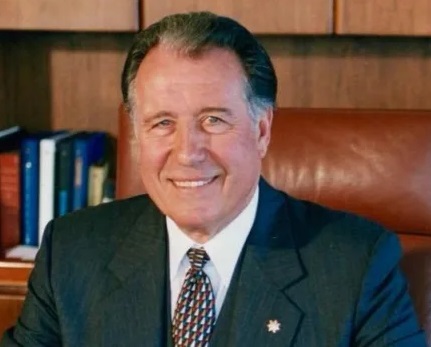
Alameda County Sheriff Charlie Plummer. He joined the Berkeley Police Department as an officer in 1952, was named Hayward Chief of Police in 1976, and was Alameda County's 21st Sheriff from 1986 to 2007.
I asked him why the two watches? He said, “Well, one is set on California time and the other on Israel time. What time do you have your watch set on?”
I said, “I don’t have a watch. If I want to know the time, I look at my beeper.”
Charlie was flabbergasted: “Well, you need a watch. Here, take this one. It was my son’s.” He gave me his Mickey Mouse watch. I still have it.
Charlie was one of those people who are either unconcerned or oblivious about how others might see them. A day after we got settled in Israel we were taken to an Ethiopian refugee resettlement center to show us how Israel was integrating new immigrants. Groups of startled refugees were in a day room as they learned about the history of Israel and some rudimentary Hebrew phrases. We entered the room and almost immediately Charlie walked from person to person, shook their hand and introduced himself, “Hi, I’m Charlie Plummer, Alameda County.” He got some pretty vacant stares, but he worked the room like it was a group of local voters. I didn’t know if he was on “cruise control” or if this was just his way of being friendly, but I was touched with what I perceived as his kindness.
We were guests of the Israeli government, and after we were given the week’s itinerary we were asked if there was anything else of interest we’d like to see. I looked over the visits to law enforcement, military, and historical sites and commented, “Sheriff Plummer and I run jails and I see there are no visits to any jails or prisons. I wonder if that can be added? I also notice that there are no visits with Palestinian authorities. When I go home and am asked about what the Palestinian people had to say, and I have no answer, my visit will be viewed as one sided, so I wonder if something can be set up with that in mind.”
Our hosts, just a bit thrown off guard, immediately set up a late-night inspection of the Jerusalem jail (Charlie and I were the only takers from the group) and a visit to the Palestinian consulate in east Jerusalem. The jail visit was fascinating. It was what you would call an older facility – from the time of the Ottoman Empire. There were no individual cells, only large dormitory rooms. Most of the prisoners, we were told, were arrestees from the “intifada” demonstrations. Charlie was in fine form. He had dressed down, wearing a red windbreaker. Prisoners came up to him and asked, “Red Cross? Red Cross?” Charlie nodded sagely and looked concerned. Later we met with the jail captain and a few staff. The captain didn’t speak English, so one of the staff acted as interpreter. This was when I came to realize that cops are cops no matter where you are. The captain asked, “If your car breaks down and is put in the shop, do you get a replacement?” Obviously, he didn’t. That was the level of the international law enforcement exchange.
When we went to the Palestinian Consulate in East Jerusalem, our guide, a sergeant in the Israeli Army, would not enter the house with us. It is amazing what things we take for granted. One of our hosts explained the travel restrictions under which they lived: since they could not become citizens of Israel, they could not get passports – they were stateless - therefore they could not leave Israel or travel anywhere. So, I asked why doesn’t Israel allow them to become citizens? They explained, if that happened they would also have the right to vote and with the Palestinian birth rate easily exceeding the Israeli’s it would not be long before the Palestinian voters would be the majority and, poof!, there would be no more Israel. It was an eye-opening exchange.
A few days later we were in Tel Aviv and Charlie and I used our break time to take a walk in one of the nicer business districts. When Charlie was in a shop looking for a gift, I sneaked over to a tobacco shop and bought a couple of Cuban cigars. Knowing that Charlie was a serious cigar smoker, I later asked him if he had ever smoked a Cuban cigar. Charlie, being a straight shooter replied, “No. They are illegal.” I pulled out a cigar and said, “Not here they’re not.” Charlie took about three seconds to process that and happily lit up the stogie.
So after that I started to regularly attend the annual CSSA conferences. No doubt, I learned a few things, but it was also just a way to get out of the office and away for a few days. Usually, I chose the conferences where my wife Beverly might enjoy the outing – San Diego, San Luis Obispo, etc. If the conference was closer to home, I would just drive to the conference meetings on a day by day basis and then drive back home in the evening.
The State Sheriff’s Association also hosted an annual “training” conference, held in Visalia in Tulare County. Now, Tulare is a truly remote rural southern valley county, and in 1985 Visalia had a population of 70,000, so I have no idea how this tradition came about but it was a yearly main even for the State’s sheriffs. Of course, the remoteness of Visalia led to a complete lack of media scrutiny and there was some level of accepted misbehavior by a few of the elected Sheriffs. It was legend that the Orange County Sheriff Brad Gates had a “minder” (body guard) who accompanied him to the conference to keep him from getting into conflicts with the locals. I attended a number of the Visalia training conferences and did not see any negative interactions with the locals, but there was copious drinking, cigar smoking and ribald joke telling at the frequent cocktail hours. Much of it definitely not politically correct.
After a couple of years of attending meetings and not causing too much conflict, I was invited by the new President of the Association, El Dorado Sheriff Richard Pacillio, to be a member of the Association’s Executive Committee. El Dorado is a small county next to Lake Tahoe on the Nevada/California state line. I don’t know why he invited me to be on the Executive Committee, but it was an honor I could not refuse. The CSSA Executive Committee met quarterly and voted on whether to endorse state legislation and state office candidates.
I knew that my politics were very much to the left of where the group stood, but there also were issues that we had in common and when there were conflicts, the group just basically ignored my dissenting vote. I think everyone saw the lack of unanimity as another aspect of our jurisdictional differences.
The Association had all sorts of sub-committees. One of the most secretive was a sub-committee on “qualifications” required to seek the office of Sheriff. From California’s beginning in 1850 until 1988, there was no state law determining who could seek the office of Sheriff other than the requirement of being a registered voter in the county. As a result, powerful Sheriffs who were certain to be re-elected often had to mount campaigns when a “pest” candidate, such as fringe activists or the wife of an inmate, filed to run against him. For an incumbent sheriff (or any elected official), for obvious reasons it is much preferable to run unopposed. Big surprise. It was fairly rare for a non-law enforcement officer to file for the office of sheriff and win, but guess who represented the biggest turd in the punch bowl?
The qualification sub-committee was mostly composed of guys holding the rank of Undersheriff or Captain, men who saw themselves as the heir apparent to the throne. (And I use the term “guys” intentionally since there had never been a woman sheriff or undersheriff in California at that time.) The argument was that there were minimum qualifications for offices like Attorney General, or County Counsel or Judge, so why not for the office of Sheriff? Of course, the real reason was to eliminate potentially pesky competition and keep the office “in house” as much as possible.
The sub-committee drafted legislation that met with approval of the Association and Senator Ed Davis of Los Angeles agreed to be the sponsor. It might be no surprise that Ed Davis was a “law and order guy,” having been the Los Angeles Chief of Police for ten years prior to entering politics. The basics of the proposal stated that in order to qualify to run for the office a person had to be a graduate of a certified California peace officer academy and also have a certain combination of education and actual law enforcement employment.
To my mind, the formula was rather ridiculous. For example, a person with a Master’s Degree needed only one year of law enforcement employment, while some dummy with four years of employment was eligible with only a high school degree. And, of course, the requirement that the person be a graduate of a certified California academy eliminated most every law enforcement executive in the rest of the country, including, for example, the Director of the FBI, Four Star Army Generals, and even the President of the United States. Finally, there was one afterthought qualification, probably added reluctantly, which read “All persons holding the office of sheriff on January 1, 1989 shall be deemed to have met all qualifications required for candidates seeking election or appointment to the office of sheriff.” Namely: me.
When the legislation went to its first committee hearing and Senator Ed Davis finally became fully informed of the details of his own legislation, he balked. Davis had joined the LAPD in 1948, before the advent of State certified police academies. He listened to the presentation and then withdrew the legislation because it declared that he wouldn’t have been eligible to run for sheriff under his own proposed law! The moment was one of great embarrassment to the Association, but not so embarrassing that they didn’t find a new sponsor and submit the legislation the following year.
After more carefully selecting a sponsor, the legislation wound its way through the legislature and landed on the desk of Governor George Deukmejian, a conservative Republican, a former State Attorney General and “friend” of law enforcement. I was the only Sheriff to oppose the legislation and even wrote to the Governor explaining that the law declared him to be incompetent to serve as Sheriff of Alpine County, population 1,200. I received no reply and at the 1987 State Sheriff’s Association Annual Conference, Governor Deukmejian made a special appearance for the purpose of signing the new legislation into law.
The applause was just one person short of unanimous.
The law was unsuccessfully challenged in the courts several times and remains on the books today. California Government Code 24004.3. I guess that since I held the office of Sheriff on January 1, 1989, I could still run for county sheriff, but no one else like me can ever run again.
Of course, just because someone has graduated from a police academy and has been accepted into the law enforcement family doesn’t mean that you are getting a quality candidate for the office of Sheriff. For example, during my years in office four perfectly qualified elected sheriffs would be convicted of felonies and sentenced to prison:
Rod Graham, Sheriff of Yolo County, convicted of a felony in 1990, served less than a year. Extortion of less than $4,000.
Mike Corona, Orange County Sheriff, convicted by a jury of a felony in 2009, witness tampering, sentenced to 66 months in Federal prison.
Los Angeles Sheriff Lee Baca, convicted of a felony in 2017, obstruction of justice. Sentenced to 3 years in Federal prison in 2020 (after losing appeals).
Baxter Dunn, Sheriff of San Joaquin County, pled to a felony (mail fraud) in 2005, did six months Federal time. In 2011, his conviction was overturned because although he did use his position to influence a county contract, the underlying legislation only applied to elected legislators.
Another issue of major conflict came in 1986 when the Chief Justice of the California Supreme Court, Rose Bird, came before the voters for “reconfirmation.” Rose Bird was appointed to the Supreme Court in 1977 by Governor Jerry Brown, but had never served as judge prior to her appointment. In fact, she had been a public defender and was a well-known opponent of the death penalty. She had served as Chief Justice for ten years when she had to face a vote to be reconfirmed. During her tenure as Chief Justice she never voted to affirm any death penalty case.
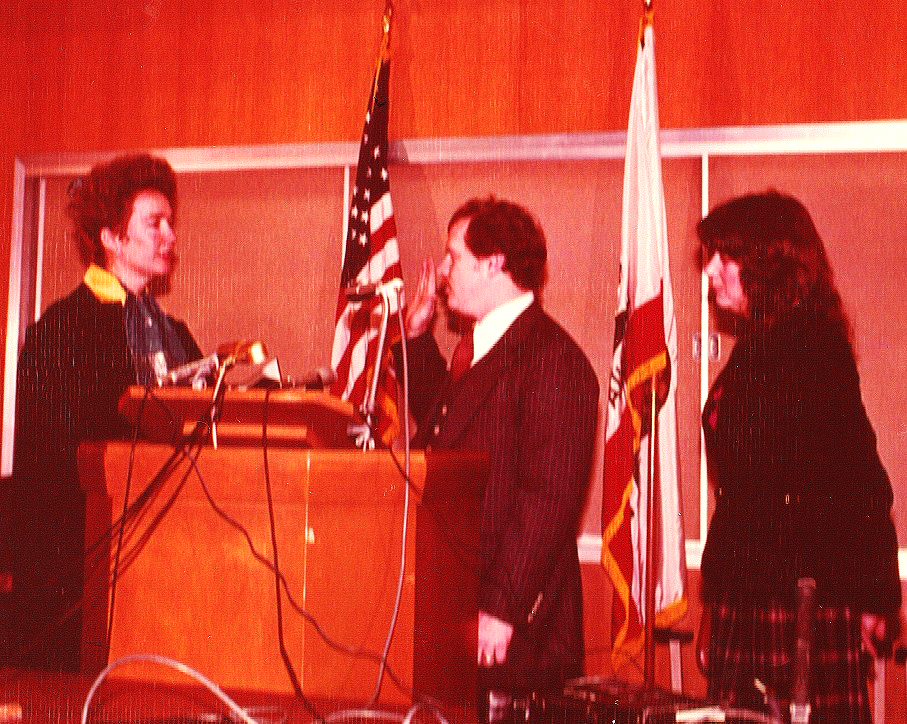
California Supreme Court Chief Justice Rose Bird swears me in for my first term as San Francisco's Sheriff in 1980, joined by my wife Beverly.
As a member of the State Sheriff’s Association Executive committee, I tried to attend as many of the quarterly meetings as possible, but some of the ones in southern California were difficult to attend. So, it happened that in the summer of 1986 the Sheriff’s held their quarterly meeting at Lake Arrowhead in Riverside County. I didn’t attend. Unknown to me, the group voted to take a public position opposing the reconfirmation of Rose Bird.
A day or two after the State Sheriffs meeting, I was surprised to get a phone call from one of Chief Bird’s staff attorneys. He asked me if it was true that I opposed her reconfirmation. I said, “Not at all. I support her.” He then explained that the State Sheriffs had issued a press release from Lake Arrowhead to the effect that the State Sheriffs were unanimous in their opposition to the reconfirmation of Rose Bird. I suppose it was true that of those present at the meeting the vote was unanimous, but not all 58 county sheriffs were present. So, Chief Bird’s person asked whether they could respond publicly that there was no unanimity among the state sheriffs. Of course, I agreed.
The resulting public undermining of the claim of “unanimity” boasted by the CSSA was embarrassing for the Association but had no ultimate impact as Chief Justice Bird was handily rejected by the voters in November 1986 and removed from office.
Not long after the controversy became public, I got a phone call from the new president of the State Sheriffs Association, Sheriff Brad Gates of Orange County. Good ol’ boy Brad told me that since the removal of Rose Bird was a priority for the Association and since I was on the other side of the issue “we’d be more comfortable and probably you’d be more comfortable if you were no longer on the Executive Committee.” I said, “Well, Brad, since the President appoints the Executive Committee, it’s your call to make.” And that was the end of my tenure on the State Sheriff’s Executive Committee.
My active participation with the CSSA diminished considerably for several years after that experience. Eventually, I again attended the annual conference, mostly just to keep up to date on professional issues and to get out of the office for a couple of days. I recall attending the conference one year in San Luis Obispo County where we had the opportunity to attend a special tour of the Hearst Castle arranged for the Sheriffs. As Beverly and I waited for the tour bus in a staging area – and I was still somewhat of a pariah – the sheriff of Yolo County, Rod Graham, brought his wife over to us for an introduction and said, jokingly, “This is Sheriff Hennessey – you know, the guy no one will talk to.” And this was from one of the guys who actually liked me.
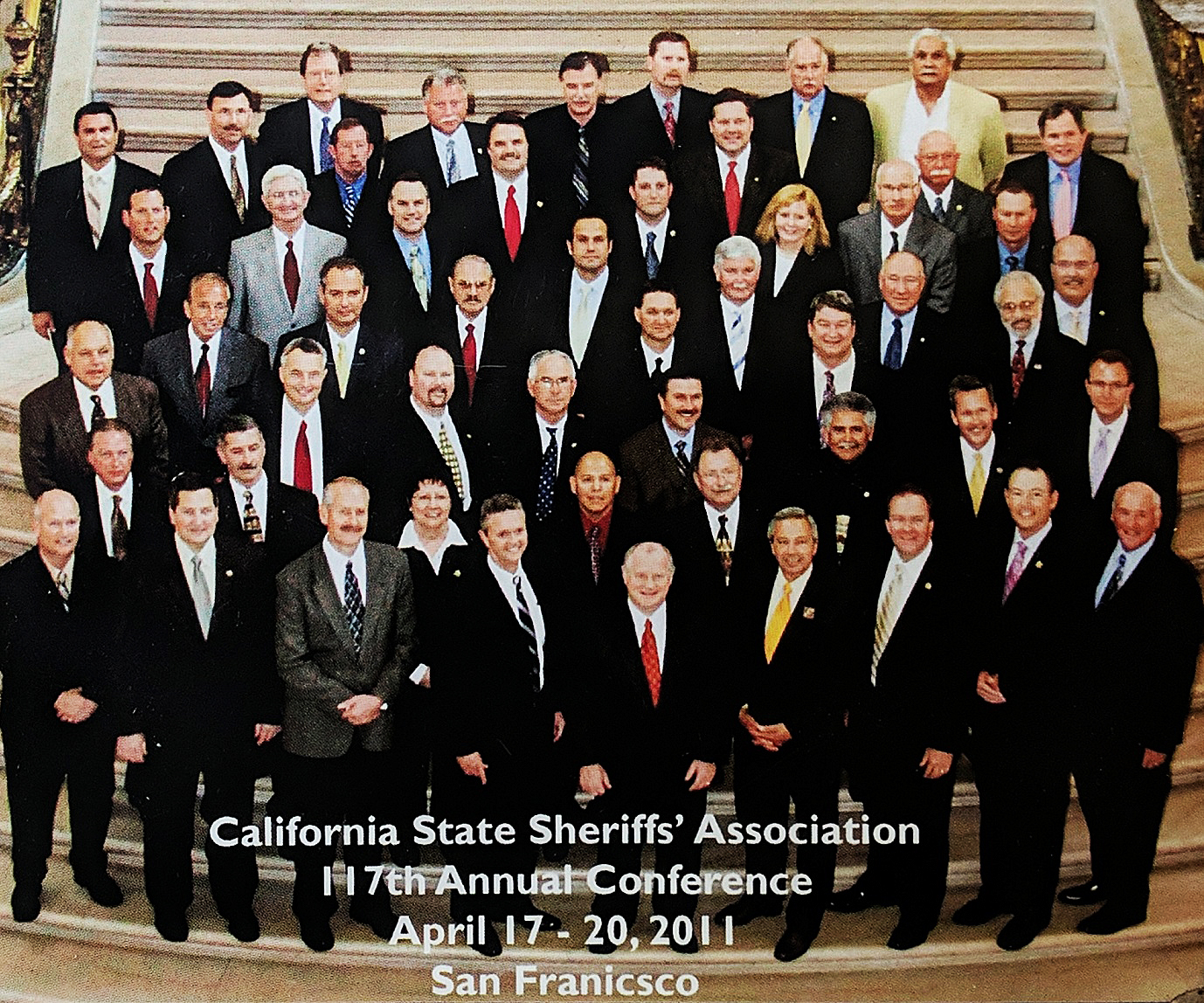
I hosted the April 2011 State Sheriffs' Association Conference, and we all gathered on the steps of City Hall for our group photo.
You’ll notice that when referring to the Sheriffs I often say “guys.” When I became Sheriff in 1980, no woman had ever been elected Sheriff in any California county. Eventually this changed, but not without controversy. In 1998 a woman named Virginia Black was elected Sheriff of Yuba County. As in many counties, there is a June primary and a November General election, if necessary. Virginia won the election outright in June, but wasn’t scheduled to take office until January of 1999. During that six month between her election and taking the oath of office, the defeated sheriff, a man very popular within the State Sheriff’s Association, would not meet with her or allow her access to the office or the jails of the county, even though she was the sheriff-elect.
Also later in 1998, Laurie Smith was elected Sheriff of Santa Clara County, the second woman to be elected in California. While Virginia Black was somewhat standoffish, served only briefly as Sheriff, and was understandably not too involved with the State Sheriffs, Laurie Smith was repeatedly reelected to office and eventually was elected President of the State Sheriff’s Association, after years of politely enduring references in State Sheriff meetings as “the girl sheriff,” the “blonde sheriff,” and other sexist references by members of the Association.
While I have always had mixed feelings about the State Sheriff’s Association and the elected Sheriffs of California, I generally feel that voters get the Sheriff they deserve. In more progressive counties like Santa Cruz, Marin and San Francisco, you see Sheriffs pioneering rehabilitation programs that are sometimes eventually adopted by the more conservative Sheriffs when they see the public acceptance and lack of negative feedback. I certainly enjoyed meeting most of the elected Sheriffs during my years in office and was generally treated with courtesy, if not respect. I recall being accosted at more than one conference by mid-management officers because I had made disparaging comments about episodes of police brutality seen during televised arrests. “Why don’t you just butt out,” was thrown angrily in my face several times.
But I don’t think I was ever publicly insulted by an elected Sheriff, unless you count that Rose Bird incident during which Los Angeles Sheriff Sherman Block dismissed me in the newspapers as “being out of touch with law enforcement.”
Which I took as a supreme compliment.
